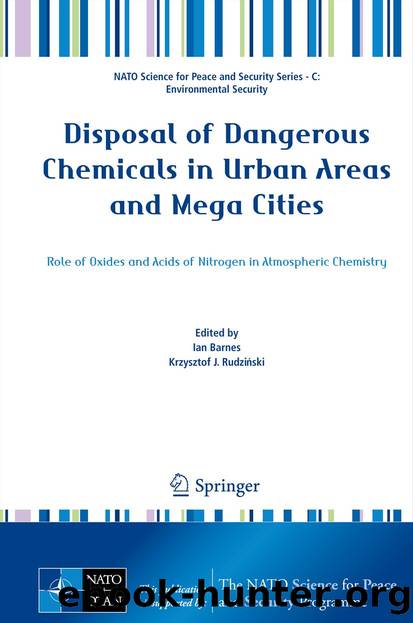Disposal of Dangerous Chemicals in Urban Areas and Mega Cities by Ian Barnes & Krzysztof J. Rudziński

Author:Ian Barnes & Krzysztof J. Rudziński
Language: eng
Format: epub
Publisher: Springer Netherlands, Dordrecht
The relative energies of the intermediates, IM1-Y, and TS1-Y are tabulated in Table 13.1. For m-cresol, the three IM1-Y structures have almost the same energies whereas there is an energy difference for the two IM1-Y structures for o-cresol. The transition states TS1-Y are best stabilized if the NO2 has been added ortho to the –OH group (e.g. at C2 or C6 position). For m-cresol the transition state, TS1-6, is better stabilized than TS1-2, this may indicate that addition to C6 is preferential compared to C2 addition. The energy barrier associated with the 1,4-elimination of HNO3 from carbon atoms located at opposite side of the carbon ring like IM1-4 is greater than the one associated with the 1,2-elimination of HNO3 from adjacent carbon atoms like IM1-2 or IM1-6. It is more favorable for 1,2-elimnation than 1,4-eliminations.
The following methyl-nitrophenol isomers are formed in the NO3 initiated reaction; 4-methyl-2-nitrophenol for p-cresol, and 5-methyl-2-nitrophenol (major product), 3-methyl-2-nitrophenol and 3-methyl-4-nitrophenol for m-cresol, and 2-methyl-4-nitrophenol for o-cresol.
The rate determining step for the addition-elimination reaction channel is the addition of NO3 to the aromatic ring. The energies of the transition states describing the addition are 7 kcal/mol or less above the individual reactants.
Download
This site does not store any files on its server. We only index and link to content provided by other sites. Please contact the content providers to delete copyright contents if any and email us, we'll remove relevant links or contents immediately.
| Automotive | Engineering |
| Transportation |
Whiskies Galore by Ian Buxton(41544)
Introduction to Aircraft Design (Cambridge Aerospace Series) by John P. Fielding(32893)
Small Unmanned Fixed-wing Aircraft Design by Andrew J. Keane Andras Sobester James P. Scanlan & András Sóbester & James P. Scanlan(32581)
Craft Beer for the Homebrewer by Michael Agnew(17940)
Turbulence by E. J. Noyes(7720)
The Complete Stick Figure Physics Tutorials by Allen Sarah(7151)
Kaplan MCAT General Chemistry Review by Kaplan(6606)
The Thirst by Nesbo Jo(6452)
Bad Blood by John Carreyrou(6286)
Modelling of Convective Heat and Mass Transfer in Rotating Flows by Igor V. Shevchuk(6232)
Learning SQL by Alan Beaulieu(6045)
Weapons of Math Destruction by Cathy O'Neil(5854)
Man-made Catastrophes and Risk Information Concealment by Dmitry Chernov & Didier Sornette(5674)
Digital Minimalism by Cal Newport;(5398)
Life 3.0: Being Human in the Age of Artificial Intelligence by Tegmark Max(5199)
iGen by Jean M. Twenge(5171)
Secrets of Antigravity Propulsion: Tesla, UFOs, and Classified Aerospace Technology by Ph.D. Paul A. Laviolette(5014)
Design of Trajectory Optimization Approach for Space Maneuver Vehicle Skip Entry Problems by Runqi Chai & Al Savvaris & Antonios Tsourdos & Senchun Chai(4849)
Electronic Devices & Circuits by Jacob Millman & Christos C. Halkias(4760)
